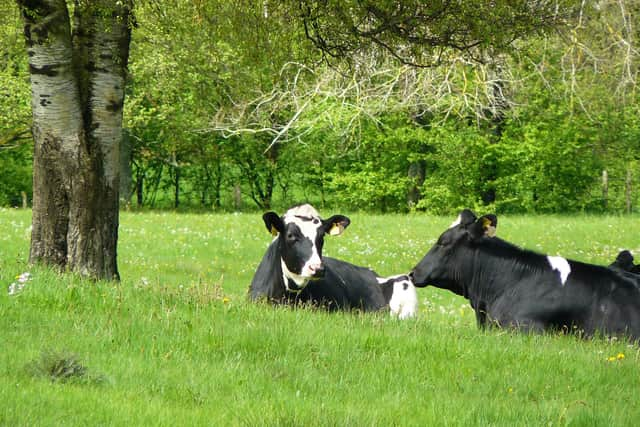We can rethink our landscapes and allow farmed animals to experience the joy of living - Philip Lymbery
As a visitor activity it is unlikely to compete with the country’s most famous attractions – like Times Square or Disneyland.
But after my visit to drought-stricken California, that cowpat on the natural pasture of a non-intensive cattle ranch, alive with a riot of different grasses, herbs and wildflowers, was truly uplifting.
Advertisement
Hide AdAdvertisement
Hide AdThis is because it contained a life-giving, hive of activity. Dung beetles – among the many creatures that rancher Jim Hagenbarth described as the “little guys” — were on their daily mission to save our earth. Their shiny black and russet striped bodies emerged as we poked gently at the cowpat to see them hard at work fertilising the soil with poo.
“These are ‘the little guys’ that make things work,” Jim said, referring to them and the other insects, birds and bees busy in his grassland. “We don’t pay enough attention to them. And if we lose those, we’re done.”
Jim’s biodiverse haven has been in his family for more than 100 years; around 5,000 free-ranging cattle are farmed annually. His ranch was a welcome contrast to the depressing dairy mega-farms in California’s Central Valley. There, I saw up to 12,000 cows confined to a single paddock and not a blade of grass in sight. Those kinds of farms use a huge amount of water, whilst all too often being responsible for polluting waterways as well as the soil as a life-giving force.
Jim’s little guys would have been hard-pressed to survive in these agricultural deserts. And what has always haunted me is that protagonists of industrial agriculture see these kinds of mega-farms as the way forward for Britain and Europe.
Last week, the global strain now put on our soil was marked by World Drought and Desertification Day. According to the UN droughts are among the


greatest threats to sustainable development, especially in developing countries, but increasingly so in developed nations too. In fact, forecasts estimate that by 2050 droughts may affect over three-quarters of the world’s population.
Yet, how many world leaders are acting on the evidence that drought, desertification and starvation happen when we treat our animals and our soil like dirt? When we incarcerate animals, removing them from the land and thereby preventing them being part of the age-old cycle of soil replenishment with their cowpats?
Factory farming and the fields of monocultures – soy and grain – grown to fuel our insatiable demand for meat is turning our soil to dust by savaging biodiversity and draining our world’s water. Rearing animals on factory farms where they are fed grain uses 40 times more water than feeding animals on grass. The water used to produce a kilo of beef equals one person’s daily baths for three months.
Advertisement
Hide AdAdvertisement
Hide AdBut there is a healthy, planet-friendly alternative: pasture-fed farmed animals. By keeping animals on pasture, we avoid some of the worst consequences, protecting rivers and underground water sources, our soil and its life-giving biodiversity.
Already more than a billion people live in conditions of extreme water shortage. Three-quarters of the planet’s land area is already degraded, with
predictions suggesting more than 90 percent could become degraded by 2050.
The impact on people is already being felt; East Africa is in a clear and immediate crisis given therehave been four successive seasons of failed rains. The war in Ukraine has meant that wheat exports have not been getting through. In Somalia alone, 386,000 children have been left in acute need of lifesaving treatment for severe malnutrition.
Gut-wrenching scenes are being reported of parents burying their children at roadsides as they die enroute in search of food and medical treatment.
The reality is that the way we farm has a big bearing on the problem in East Africa and elsewhere.
Taking animals off the land and into intensification creates a wasteful, grain-guzzling way of rearing livestock.
As I explored in a recent column, we are perpetuating a truly inefficient way of feeding our world: the UK and EU combined use 50 million tonnes of wheat a year as animal feed – three times the total amount of wheat normally exported annually by Ukraine.
Advertisement
Hide AdAdvertisement
Hide AdNever has it been more important for the world’s leaders to place ending factory farming firmly on the agenda. If the UK alone were to end factory farming, it could free up the equivalent of half of Ukraine’s total annual wheat exports. Imagine too the
amount of water saved.
Water shortages do not just affect countries far away, as last summer’s heatwave in Scotland showed. Most of the country was covered by drought warnings.
Environmental agency, NatureScot, predicts that serious drought could become a frequent event; hitting the country every three years instead of being every two decades.They are also predicted to last two to three months longer too, with hotspot areas including the Borders, Aberdeenshire, Caithness, Orkney and Shetland.
Ending drought involves a connected global approach to solving the issue.
By rethinking our relationship with animals and agriculture, moving to regenerative, nature-friendly farming, do we hold the key to stopping desertification and drought. In this way, we can allow farmed animals to experience the joy of living at the same time as creating landscapes bursting with life. Visionary and beautiful food systems that value our water and soil, and of course the precious “little guys”; that seems to
me to be the right way to a truly viable future for us all.
Philip Lymbery is Global CEO of Compassion in Farming International, a former United Nations Food Systems Champion and author of Farmageddon:
The True Cost of Cheap Meat and Dead Zone: Where the Wild Things Were. He is on Twitter @philip_ciwf
Comments
Want to join the conversation? Please or to comment on this article.
